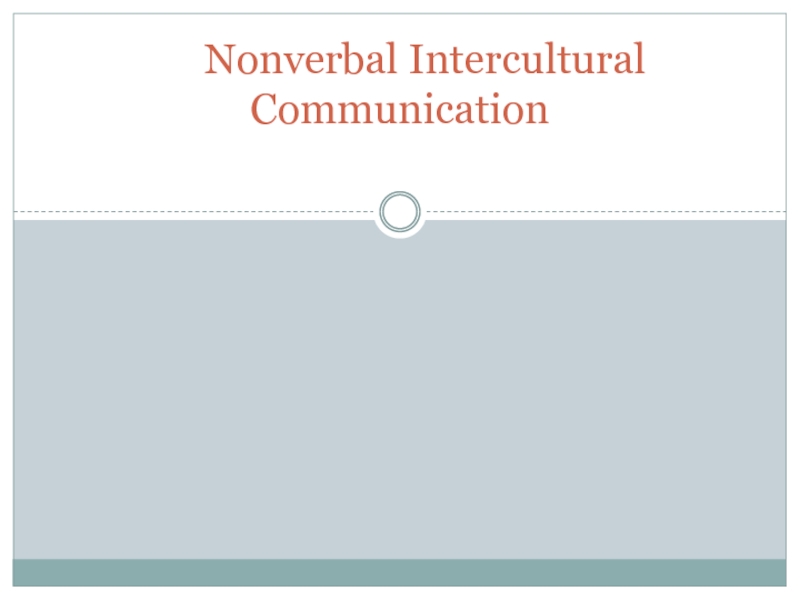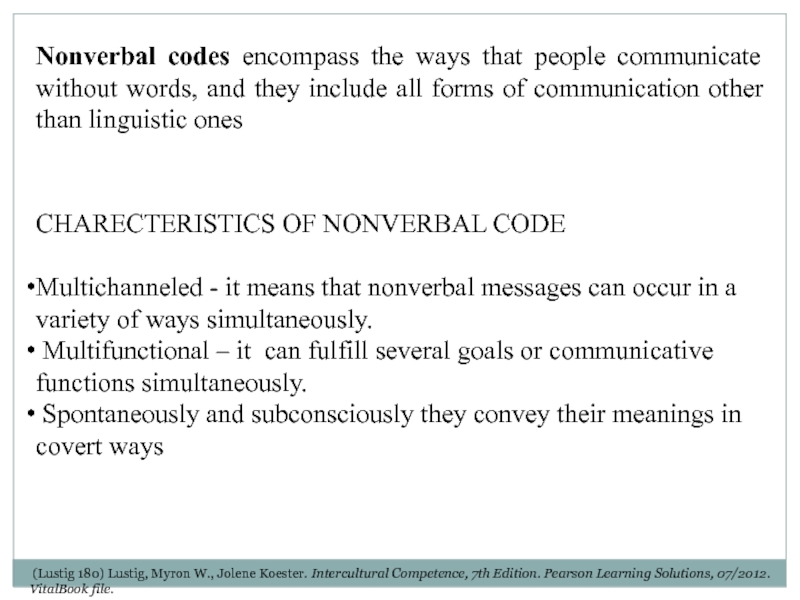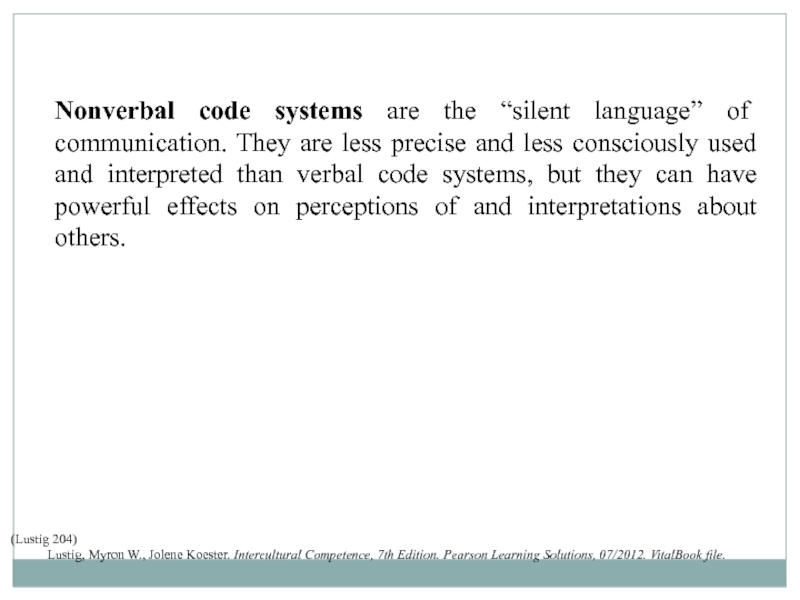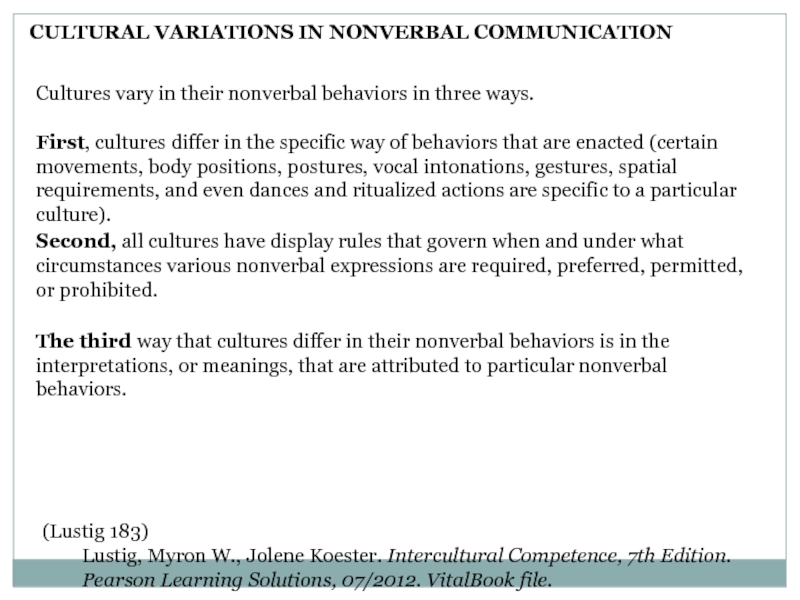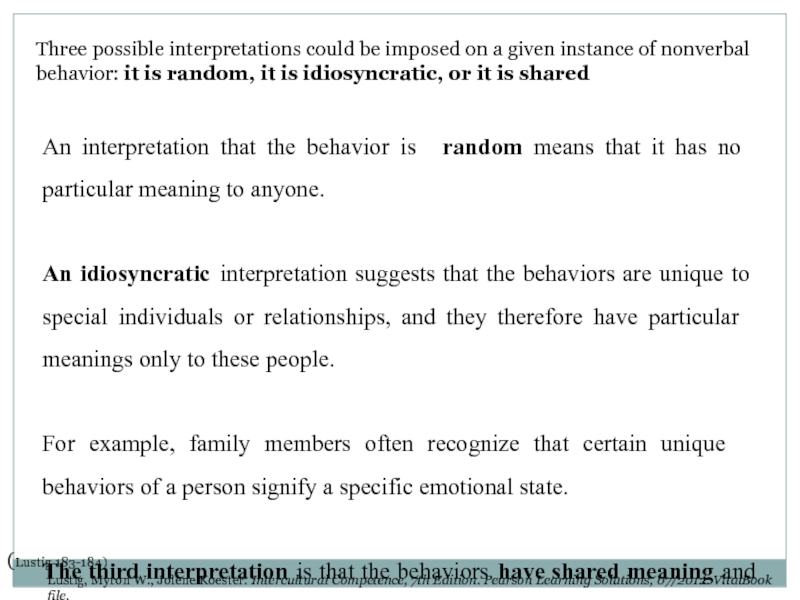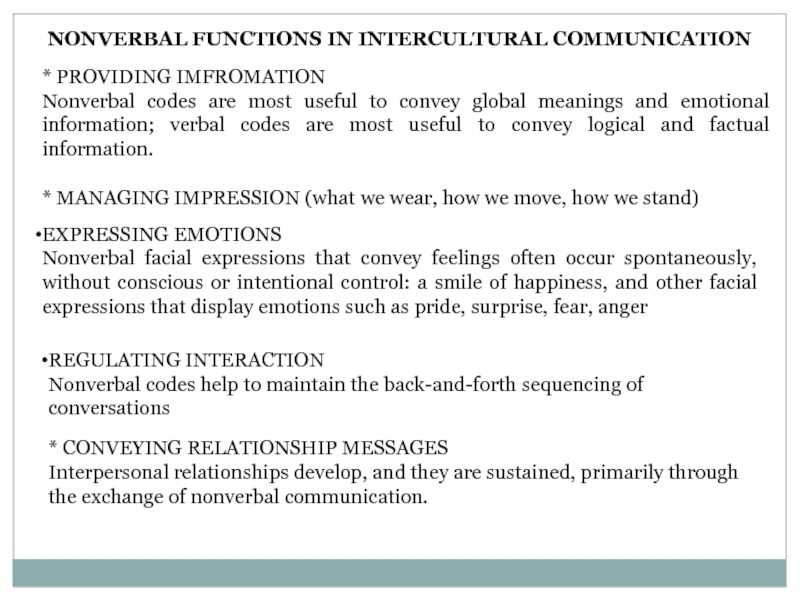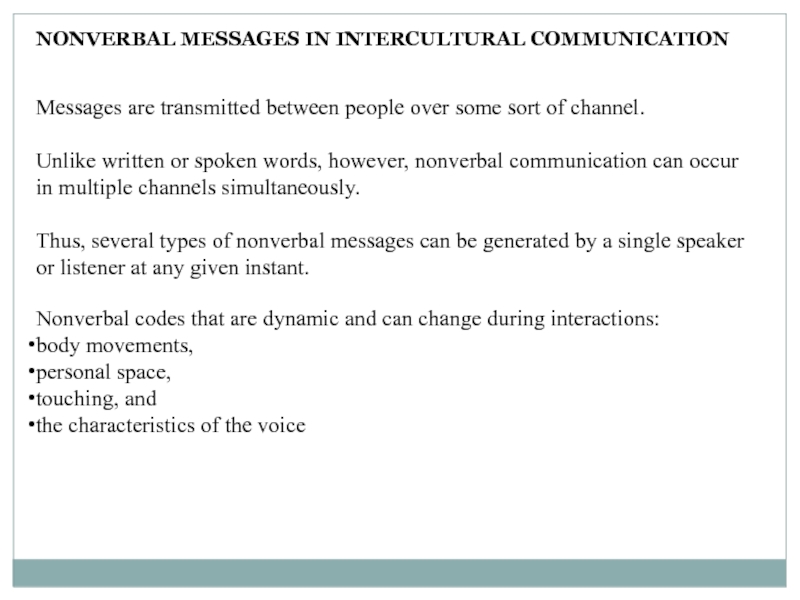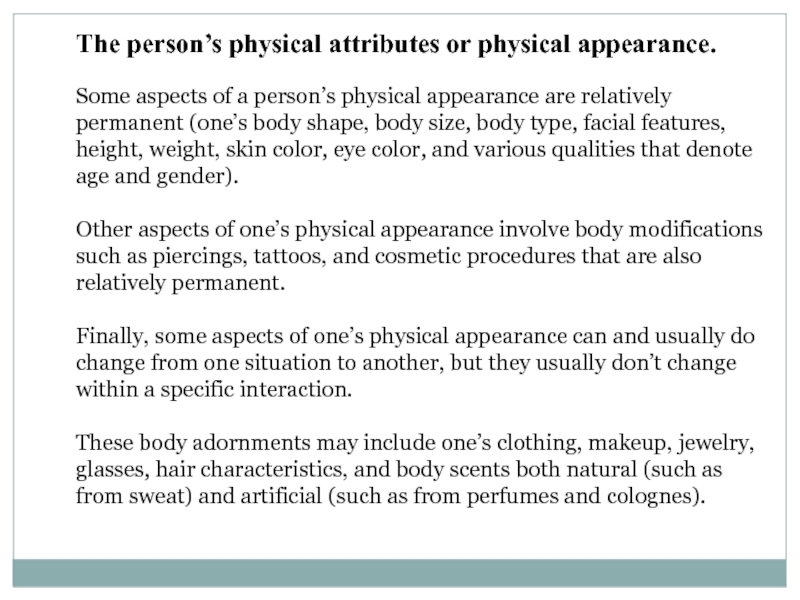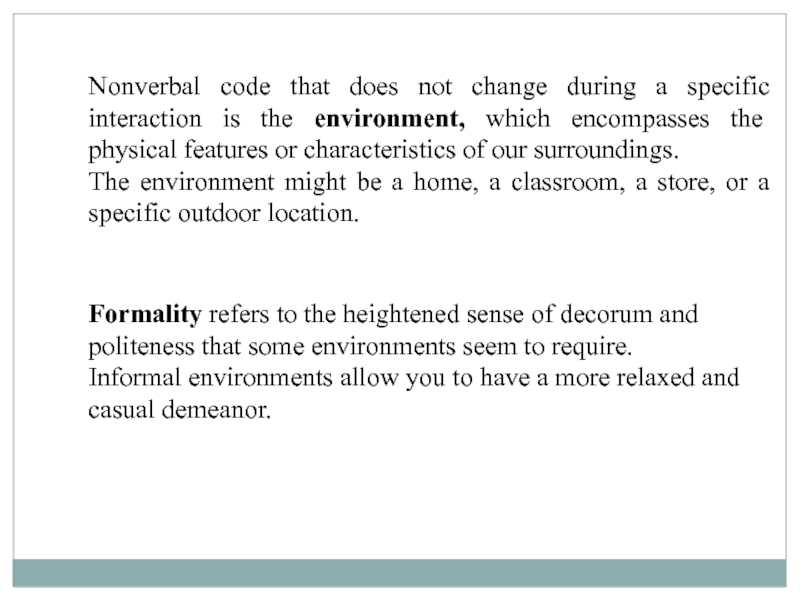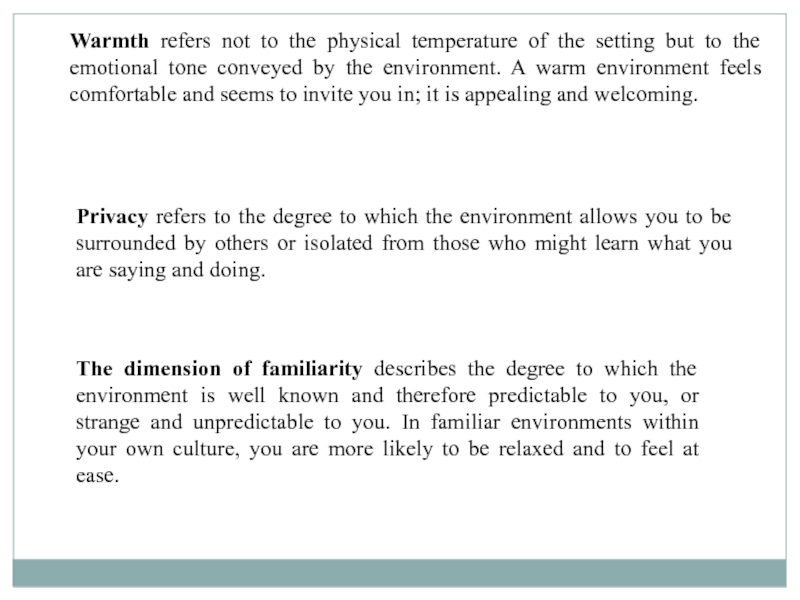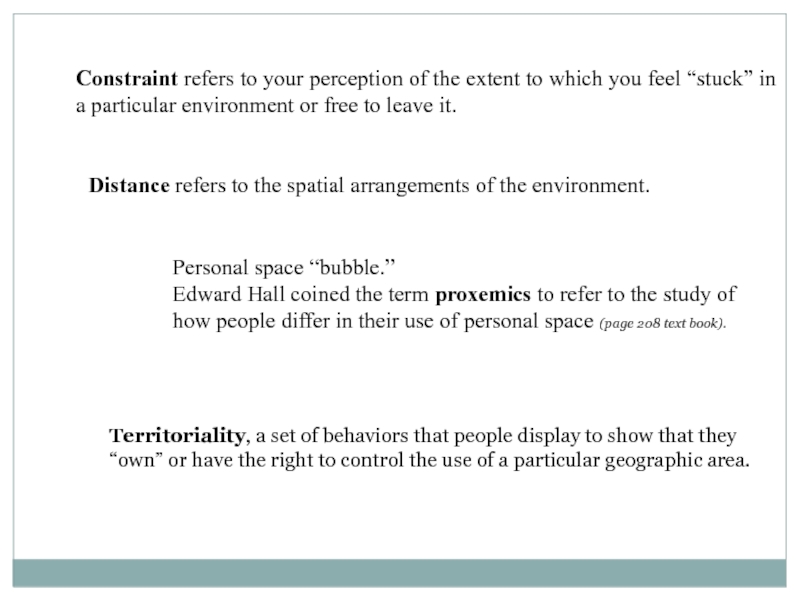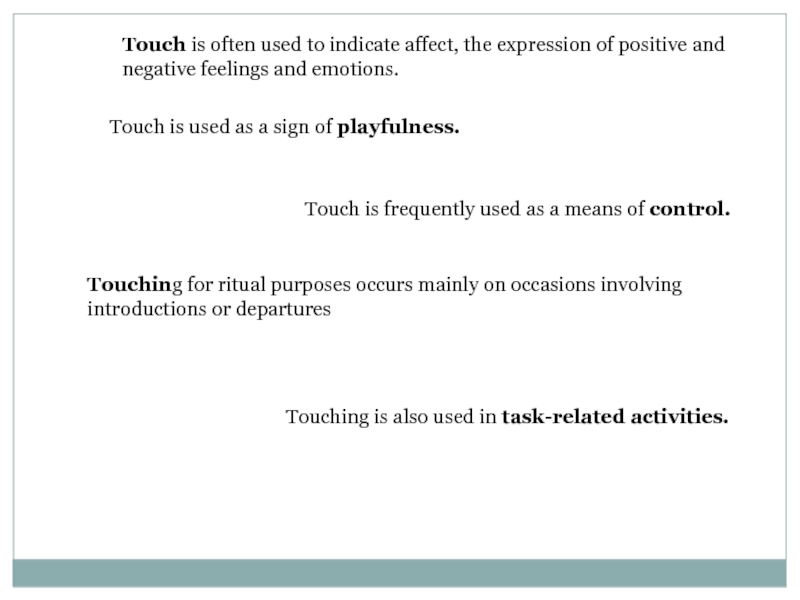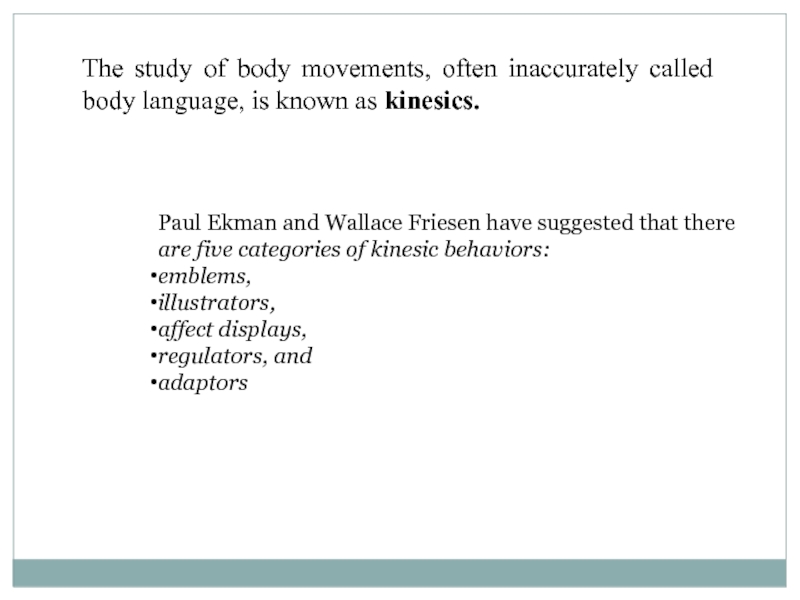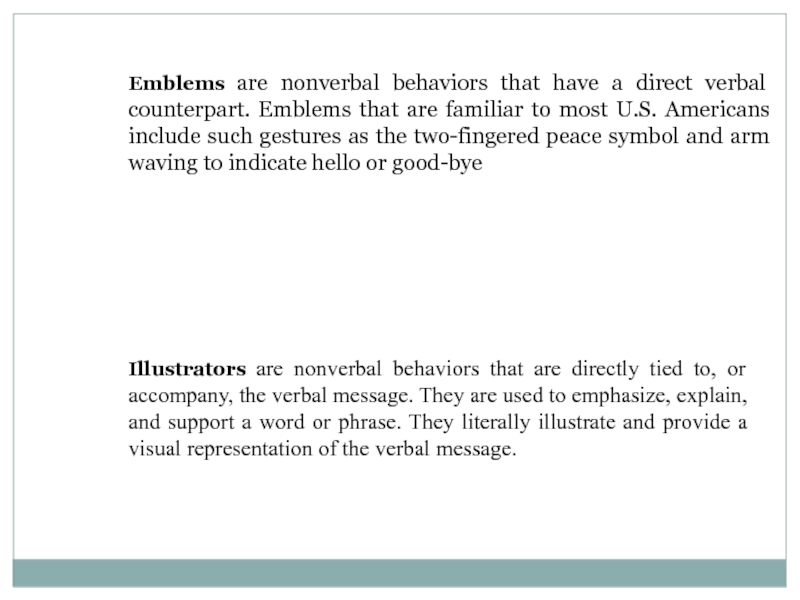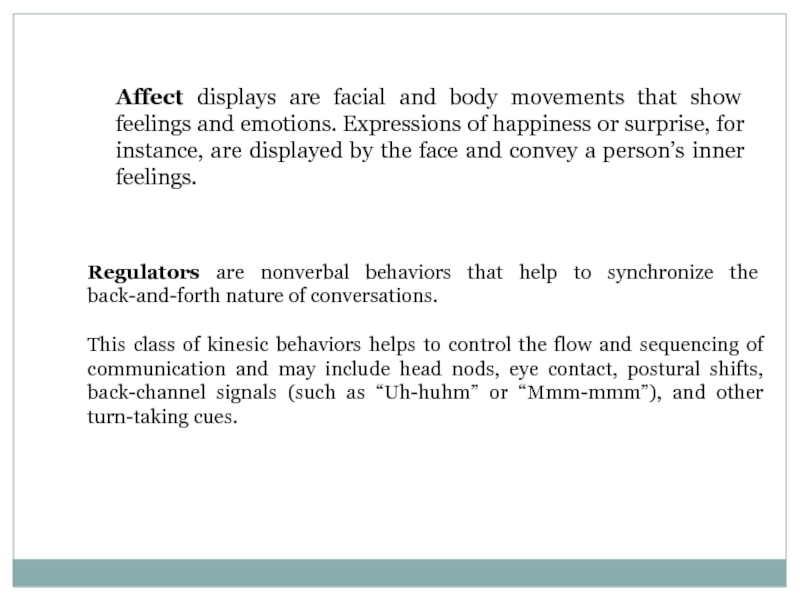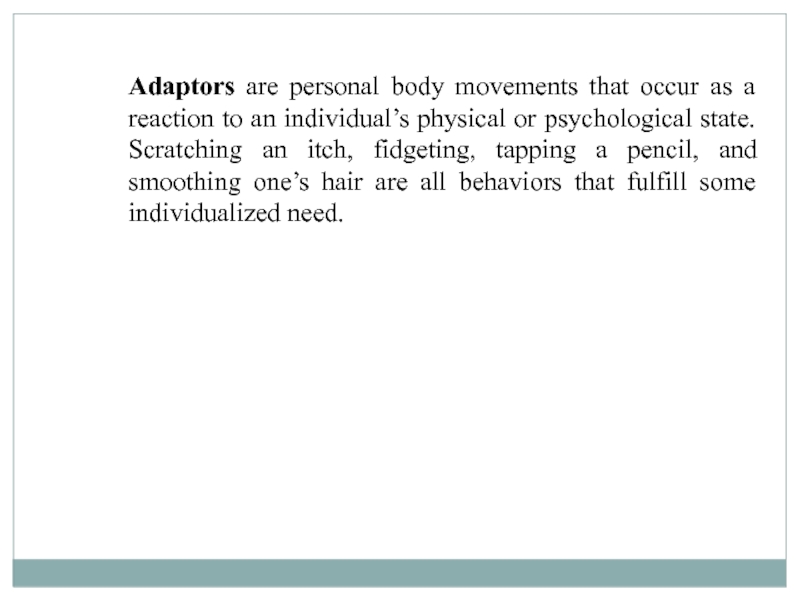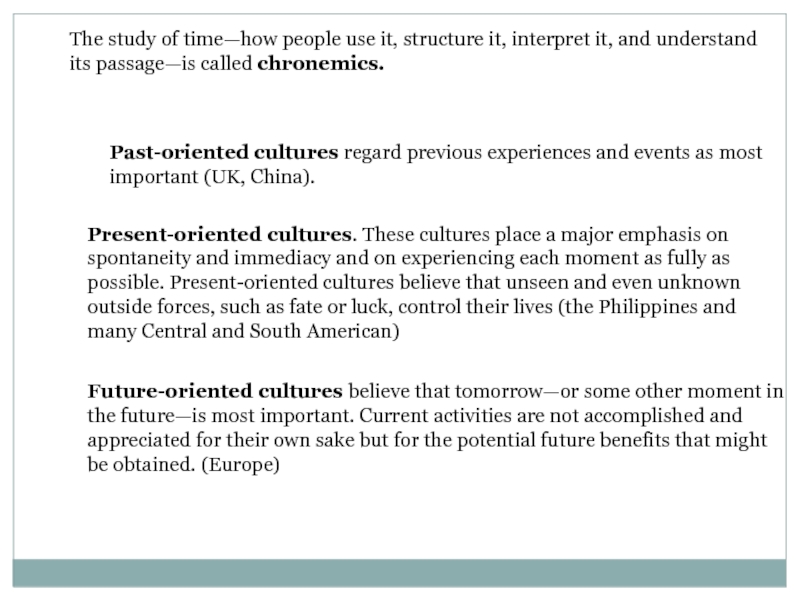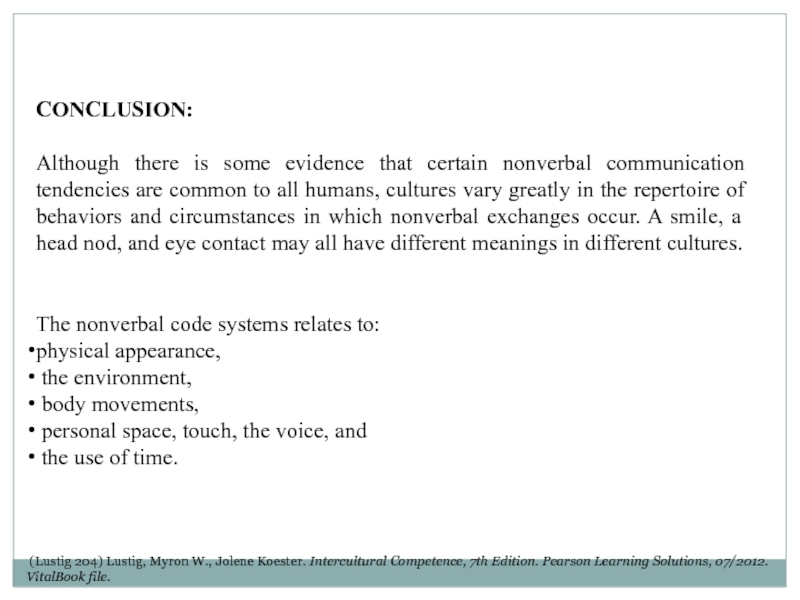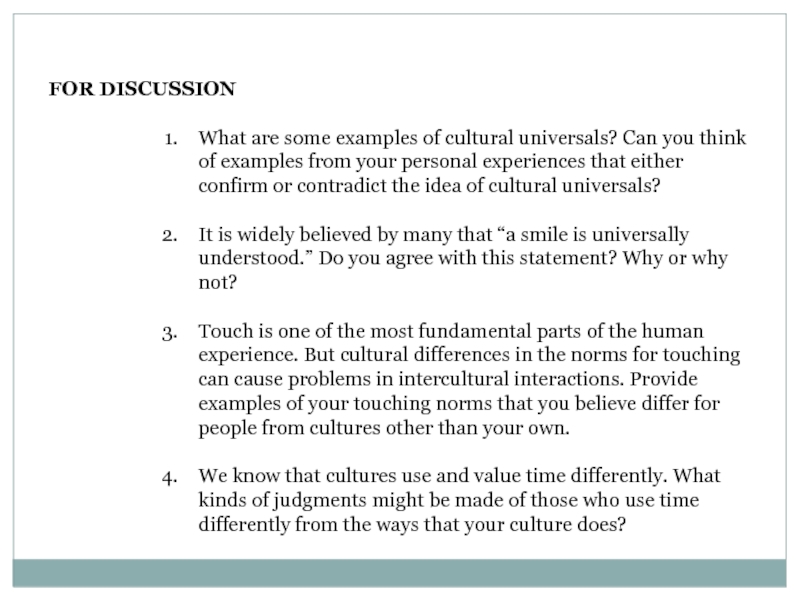- Главная
- Разное
- Дизайн
- Бизнес и предпринимательство
- Аналитика
- Образование
- Развлечения
- Красота и здоровье
- Финансы
- Государство
- Путешествия
- Спорт
- Недвижимость
- Армия
- Графика
- Культурология
- Еда и кулинария
- Лингвистика
- Английский язык
- Астрономия
- Алгебра
- Биология
- География
- Детские презентации
- Информатика
- История
- Литература
- Маркетинг
- Математика
- Медицина
- Менеджмент
- Музыка
- МХК
- Немецкий язык
- ОБЖ
- Обществознание
- Окружающий мир
- Педагогика
- Русский язык
- Технология
- Физика
- Философия
- Химия
- Шаблоны, картинки для презентаций
- Экология
- Экономика
- Юриспруденция
Nonverbal intercultural communication презентация
Содержание
- 1. Nonverbal intercultural communication
- 2. Nonverbal codes encompass the ways that people
- 3. Nonverbal code systems are the “silent language”
- 4. CULTURAL VARIATIONS IN NONVERBAL COMMUNICATION Cultures vary
- 5. Three possible interpretations could be imposed on
- 6. NONVERBAL FUNCTIONS IN INTERCULTURAL COMMUNICATION * PROVIDING
- 7. NONVERBAL MESSAGES IN INTERCULTURAL COMMUNICATION Messages are
- 8. The person’s physical attributes or physical appearance.
- 9. Nonverbal code that does not change during
- 10. Warmth refers not to the physical temperature
- 11. Constraint refers to your perception of the
- 12. Touch is often used to indicate affect,
- 13. The study of body movements, often inaccurately
- 14. Emblems are nonverbal behaviors that have a
- 15. Affect displays are facial and body movements
- 16. Adaptors are personal body movements that occur
- 17. The study of time—how people use it,
- 18. The nonverbal code systems relates to: physical
- 19. FOR DISCUSSION What are some examples
Слайд 2Nonverbal codes encompass the ways that people communicate without words, and
(Lustig 180) Lustig, Myron W., Jolene Koester. Intercultural Competence, 7th Edition. Pearson Learning Solutions, 07/2012. VitalBook file.
CHARECTERISTICS OF NONVERBAL CODE
Multichanneled - it means that nonverbal messages can occur in a variety of ways simultaneously.
Multifunctional – it can fulfill several goals or communicative functions simultaneously.
Spontaneously and subconsciously they convey their meanings in covert ways
Слайд 3Nonverbal code systems are the “silent language” of communication. They are
(Lustig 204)
Lustig, Myron W., Jolene Koester. Intercultural Competence, 7th Edition. Pearson Learning Solutions, 07/2012. VitalBook file.
Слайд 4CULTURAL VARIATIONS IN NONVERBAL COMMUNICATION
Cultures vary in their nonverbal behaviors in
First, cultures differ in the specific way of behaviors that are enacted (certain movements, body positions, postures, vocal intonations, gestures, spatial requirements, and even dances and ritualized actions are specific to a particular culture).
Second, all cultures have display rules that govern when and under what circumstances various nonverbal expressions are required, preferred, permitted, or prohibited.
The third way that cultures differ in their nonverbal behaviors is in the interpretations, or meanings, that are attributed to particular nonverbal behaviors.
(Lustig 183)
Lustig, Myron W., Jolene Koester. Intercultural Competence, 7th Edition. Pearson Learning Solutions, 07/2012. VitalBook file.
Слайд 5Three possible interpretations could be imposed on a given instance of
An interpretation that the behavior is random means that it has no particular meaning to anyone.
An idiosyncratic interpretation suggests that the behaviors are unique to special individuals or relationships, and they therefore have particular meanings only to these people.
For example, family members often recognize that certain unique behaviors of a person signify a specific emotional state.
The third interpretation is that the behaviors have shared meaning and significance, as when a group of people jointly attribute the same meaning to a particular nonverbal act.
(Lustig 183-184)
Lustig, Myron W., Jolene Koester. Intercultural Competence, 7th Edition. Pearson Learning Solutions, 07/2012. VitalBook file.
Слайд 6NONVERBAL FUNCTIONS IN INTERCULTURAL COMMUNICATION
* PROVIDING IMFROMATION
Nonverbal codes are most useful
* MANAGING IMPRESSION (what we wear, how we move, how we stand)
EXPRESSING EMOTIONS
Nonverbal facial expressions that convey feelings often occur spontaneously, without conscious or intentional control: a smile of happiness, and other facial expressions that display emotions such as pride, surprise, fear, anger
REGULATING INTERACTION
Nonverbal codes help to maintain the back-and-forth sequencing of conversations
* CONVEYING RELATIONSHIP MESSAGES
Interpersonal relationships develop, and they are sustained, primarily through the exchange of nonverbal communication.
Слайд 7NONVERBAL MESSAGES IN INTERCULTURAL COMMUNICATION
Messages are transmitted between people over some
Unlike written or spoken words, however, nonverbal communication can occur in multiple channels simultaneously.
Thus, several types of nonverbal messages can be generated by a single speaker or listener at any given instant.
Nonverbal codes that are dynamic and can change during interactions:
body movements,
personal space,
touching, and
the characteristics of the voice
Слайд 8The person’s physical attributes or physical appearance.
Some aspects of a
Other aspects of one’s physical appearance involve body modifications such as piercings, tattoos, and cosmetic procedures that are also relatively permanent.
Finally, some aspects of one’s physical appearance can and usually do change from one situation to another, but they usually don’t change within a specific interaction.
These body adornments may include one’s clothing, makeup, jewelry, glasses, hair characteristics, and body scents both natural (such as from sweat) and artificial (such as from perfumes and colognes).
Слайд 9Nonverbal code that does not change during a specific interaction is
The environment might be a home, a classroom, a store, or a specific outdoor location.
Formality refers to the heightened sense of decorum and politeness that some environments seem to require.
Informal environments allow you to have a more relaxed and casual demeanor.
Слайд 10Warmth refers not to the physical temperature of the setting but
Privacy refers to the degree to which the environment allows you to be surrounded by others or isolated from those who might learn what you are saying and doing.
The dimension of familiarity describes the degree to which the environment is well known and therefore predictable to you, or strange and unpredictable to you. In familiar environments within your own culture, you are more likely to be relaxed and to feel at ease.
Слайд 11Constraint refers to your perception of the extent to which you
Distance refers to the spatial arrangements of the environment.
Personal space “bubble.”
Edward Hall coined the term proxemics to refer to the study of how people differ in their use of personal space (page 208 text book).
Territoriality, a set of behaviors that people display to show that they “own” or have the right to control the use of a particular geographic area.
Слайд 12Touch is often used to indicate affect, the expression of positive
Touch is used as a sign of playfulness.
Touch is frequently used as a means of control.
Touching for ritual purposes occurs mainly on occasions involving introductions or departures
Touching is also used in task-related activities.
Слайд 13The study of body movements, often inaccurately called body language, is
Paul Ekman and Wallace Friesen have suggested that there are five categories of kinesic behaviors:
emblems,
illustrators,
affect displays,
regulators, and
adaptors
Слайд 14Emblems are nonverbal behaviors that have a direct verbal counterpart. Emblems
Illustrators are nonverbal behaviors that are directly tied to, or accompany, the verbal message. They are used to emphasize, explain, and support a word or phrase. They literally illustrate and provide a visual representation of the verbal message.
Слайд 15Affect displays are facial and body movements that show feelings and
Regulators are nonverbal behaviors that help to synchronize the back-and-forth nature of conversations.
This class of kinesic behaviors helps to control the flow and sequencing of communication and may include head nods, eye contact, postural shifts, back-channel signals (such as “Uh-huhm” or “Mmm-mmm”), and other turn-taking cues.
Слайд 16Adaptors are personal body movements that occur as a reaction to
Слайд 17The study of time—how people use it, structure it, interpret it,
Past-oriented cultures regard previous experiences and events as most important (UK, China).
Present-oriented cultures. These cultures place a major emphasis on spontaneity and immediacy and on experiencing each moment as fully as possible. Present-oriented cultures believe that unseen and even unknown outside forces, such as fate or luck, control their lives (the Philippines and many Central and South American)
Future-oriented cultures believe that tomorrow—or some other moment in the future—is most important. Current activities are not accomplished and appreciated for their own sake but for the potential future benefits that might be obtained. (Europe)
Слайд 18The nonverbal code systems relates to:
physical appearance,
the environment,
personal space, touch, the voice, and
the use of time.
(Lustig 204) Lustig, Myron W., Jolene Koester. Intercultural Competence, 7th Edition. Pearson Learning Solutions, 07/2012. VitalBook file.
CONCLUSION:
Although there is some evidence that certain nonverbal communication tendencies are common to all humans, cultures vary greatly in the repertoire of behaviors and circumstances in which nonverbal exchanges occur. A smile, a head nod, and eye contact may all have different meanings in different cultures.
Слайд 19FOR DISCUSSION
What are some examples of cultural universals? Can you think
It is widely believed by many that “a smile is universally understood.” Do you agree with this statement? Why or why not?
Touch is one of the most fundamental parts of the human experience. But cultural differences in the norms for touching can cause problems in intercultural interactions. Provide examples of your touching norms that you believe differ for people from cultures other than your own.
We know that cultures use and value time differently. What kinds of judgments might be made of those who use time differently from the ways that your culture does?
